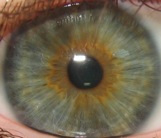Iris recognition
T he use of the iris pattern as a method of uniquely identifying individuals was proposed by ophthalmologist Frank Burch in 1936, but it was not until 1993, when Dr John Daugman published his findings on its reliability that the technology started to gain acceptance. He developed an algorithm to create a binary encoded template called an IrisCode® from a camera image taken of an iris, which he patented in 1994. It is perhaps because of this patent that iris recognition was not adopted more widely, especially in the decision taken by ICAO for the technologies they adopted for biometric international travel documents.
he use of the iris pattern as a method of uniquely identifying individuals was proposed by ophthalmologist Frank Burch in 1936, but it was not until 1993, when Dr John Daugman published his findings on its reliability that the technology started to gain acceptance. He developed an algorithm to create a binary encoded template called an IrisCode® from a camera image taken of an iris, which he patented in 1994. It is perhaps because of this patent that iris recognition was not adopted more widely, especially in the decision taken by ICAO for the technologies they adopted for biometric international travel documents.
Iris recognition has a reputation for high reliability supported by Dr Daugman's findings. In his papers Dr Daugman contends that from the age of 18 months iris recognition is a reliable biometric authentication technology.
This reputation was reinforced after the anonymous "Aghan Girl" on the cover of the December 1984 National Geographic was identified 17 years later using iris recognition.
However, this reputation for reliability is being brought into question by Professor K Bowyer of the University of Notre Dame.
Professor Bowyer's papers establish that the iris image sometimes changes with aging and there is a degradation in the FRR over time, and so is not as reliable as it's believed to be.
Advantages
Disadvantages
More at:
Analysis of Template Aging in Iris Biometrics
Don’t Blink: Iris Recognition for Biometric Identification
Effect of Severe Image Compression on Iris Recognition Performance
Empirical Evidence for Correct Iris Match Score Degradation with Increased Time-Lapse Between Gallery and Probe Matches
Experimental Evidence of a Template Aging Effect in Iris Biometrics
From the Iriscode to the Iris: A New Vulnerability of Iris Recognition Systems
From the 2007 Biometrics: Theory, Applications, and Systems Conference
High Confidence Visual Recognition of Persons by a Test of Statistical Independence
How Iris Recognition Works
Identifying Useful Features for Recognition in Near-Infrared Periocular Images
Identity Verification Using Iris Images: Performance of Human Examiners
Image Averaging for Improved Iris Recognition
Image Understanding for Iris Biometrics: A Survey
Imaging Criteria and Test Methods for Qualification of Iris Cameras
Improved Iris Recognition Through Fusion of Hamming Distance and Fragile Bit Distance
Iris recognition as a biometric method after cataract surgery
MorphoTrustTM Iris Recognition
Pupil Dilation Degrades Iris Biometric Performance
Recent research results in iris biometrics
Similarity of Iris Texture between Identical Twins
The Best Bits in an Iris Code
Toward Accurate and Fast Iris Segmentation for Iris Biometrics
Toward the next generation of iris biometrics science
T

Iris recognition has a reputation for high reliability supported by Dr Daugman's findings. In his papers Dr Daugman contends that from the age of 18 months iris recognition is a reliable biometric authentication technology.
This reputation was reinforced after the anonymous "Aghan Girl" on the cover of the December 1984 National Geographic was identified 17 years later using iris recognition.
However, this reputation for reliability is being brought into question by Professor K Bowyer of the University of Notre Dame.
Professor Bowyer's papers establish that the iris image sometimes changes with aging and there is a degradation in the FRR over time, and so is not as reliable as it's believed to be.
Advantages
- No contact required
- Protected internal organ; less prone to injury
- Believed to be highly stable over lifetime
Disadvantages
- Difficult to capture for some individuals
- Easily obscured by eyelashes, eyelids, lens and reflections from the cornea
- Public myths and fears related to "scanning" the eye with a light source
- Acquisition of an iris image requires more training and attentiveness than most biometrics
- Lack of existing data deters ability to use for background or watchlist checks
- Cannot be verified by a human
More at:
Analysis of Template Aging in Iris Biometrics
Don’t Blink: Iris Recognition for Biometric Identification
Effect of Severe Image Compression on Iris Recognition Performance
Empirical Evidence for Correct Iris Match Score Degradation with Increased Time-Lapse Between Gallery and Probe Matches
Experimental Evidence of a Template Aging Effect in Iris Biometrics
From the Iriscode to the Iris: A New Vulnerability of Iris Recognition Systems
From the 2007 Biometrics: Theory, Applications, and Systems Conference
High Confidence Visual Recognition of Persons by a Test of Statistical Independence
How Iris Recognition Works
Identifying Useful Features for Recognition in Near-Infrared Periocular Images
Identity Verification Using Iris Images: Performance of Human Examiners
Image Averaging for Improved Iris Recognition
Image Understanding for Iris Biometrics: A Survey
Imaging Criteria and Test Methods for Qualification of Iris Cameras
Improved Iris Recognition Through Fusion of Hamming Distance and Fragile Bit Distance
Iris recognition as a biometric method after cataract surgery
MorphoTrustTM Iris Recognition
Pupil Dilation Degrades Iris Biometric Performance
Recent research results in iris biometrics
Similarity of Iris Texture between Identical Twins
The Best Bits in an Iris Code
Toward Accurate and Fast Iris Segmentation for Iris Biometrics
Toward the next generation of iris biometrics science